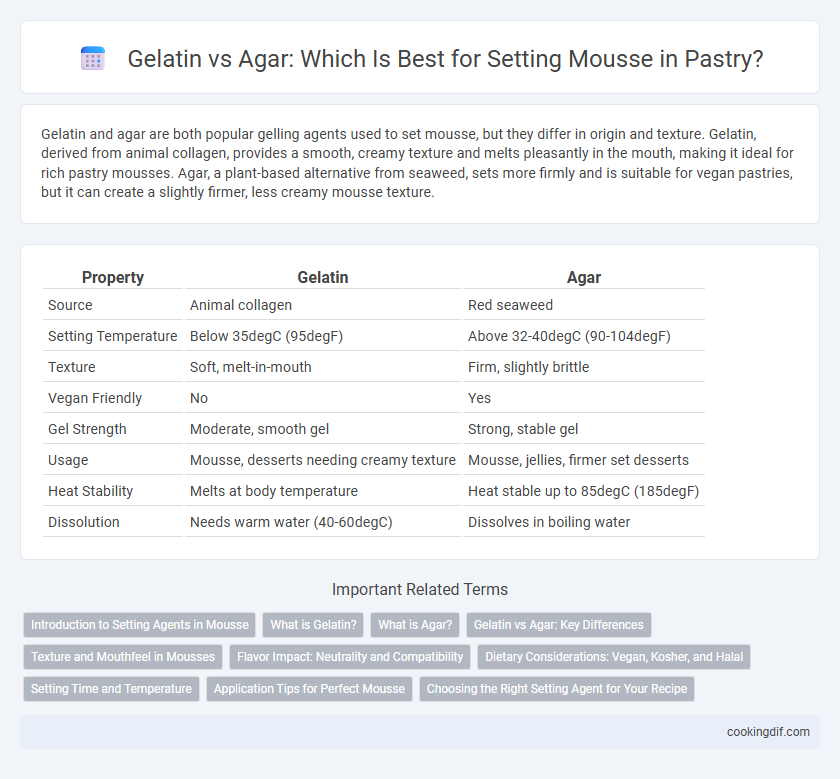Gelatin and agar are both popular gelling agents used to set mousse, but they differ in origin and texture. Gelatin, derived from animal collagen, provides a smooth, creamy texture and melts pleasantly in the mouth, making it ideal for rich pastry mousses. Agar, a plant-based alternative from seaweed, sets more firmly and is suitable for vegan pastries, but it can create a slightly firmer, less creamy mousse texture.
Table of Comparison
| Property | Gelatin | Agar |
|---|---|---|
| Source | Animal collagen | Red seaweed |
| Setting Temperature | Below 35degC (95degF) | Above 32-40degC (90-104degF) |
| Texture | Soft, melt-in-mouth | Firm, slightly brittle |
| Vegan Friendly | No | Yes |
| Gel Strength | Moderate, smooth gel | Strong, stable gel |
| Usage | Mousse, desserts needing creamy texture | Mousse, jellies, firmer set desserts |
| Heat Stability | Melts at body temperature | Heat stable up to 85degC (185degF) |
| Dissolution | Needs warm water (40-60degC) | Dissolves in boiling water |
Introduction to Setting Agents in Mousse
Gelatin and agar serve as crucial setting agents in mousse, each providing distinct textures and setting properties. Gelatin, derived from animal collagen, delivers a smooth, elastic consistency and requires refrigeration to properly set, while agar, a plant-based alternative extracted from seaweed, sets more firmly at room temperature and is ideal for vegetarian or vegan recipes. The choice between gelatin and agar impacts the mousse's mouthfeel, stability, and clarity, making understanding their functional differences essential for pastry chefs aiming to achieve the perfect mousse texture.
What is Gelatin?
Gelatin is a natural protein derived from animal collagen, primarily sourced from pigs and cows, widely used in pastry for setting mousses due to its strong gelling properties and smooth texture. It melts at body temperature, providing a creamy mouthfeel essential for delicate desserts like mousse. Compared to agar, gelatin offers a more flexible and less brittle gel, making it a preferred choice for achieving the ideal mousse consistency.
What is Agar?
Agar is a natural gelling agent derived from red algae, commonly used as a vegetarian alternative to gelatin in mousse setting. It forms a firm, stable gel that sets at room temperature and remains stable at higher temperatures, unlike gelatin which requires refrigeration. Agar's neutral flavor and strong gelling properties make it ideal for creating smooth, airy mousses with a consistent texture.
Gelatin vs Agar: Key Differences
Gelatin and agar are both popular gelling agents used in mousse setting, but they differ significantly in origin, texture, and setting properties. Gelatin, derived from animal collagen, creates a smooth, elastic texture and sets at cold temperatures, while agar, a plant-based alternative extracted from seaweed, produces a firmer, more brittle gel that sets at room temperature. The choice between gelatin and agar depends on dietary preferences, desired mousse texture, and temperature sensitivity during preparation.
Texture and Mouthfeel in Mousses
Gelatin creates a smooth, elastic texture in mousses, offering a clean melt-in-the-mouth sensation that enhances creaminess and provides a delicate mouthfeel. Agar sets mousses with a firmer, slightly more brittle structure, contributing to a denser bite and a less creamy but more gelatinous texture. The choice between gelatin and agar significantly influences the mousse's sensory experience, with gelatin preferred for silky softness and agar favored for stability and a distinctive chew.
Flavor Impact: Neutrality and Compatibility
Gelatin provides a clean, neutral flavor that preserves the delicate taste of mousse, making it ideal for fruit-based and subtle desserts. Agar, derived from seaweed, can impart a mild vegetal or marine note that may slightly alter the mousse's flavor profile. When prioritizing flavor compatibility, gelatin is preferred for its minimal impact, ensuring the mousse's ingredients shine without interference.
Dietary Considerations: Vegan, Kosher, and Halal
Agar is a plant-based gelling agent derived from seaweed, making it suitable for vegan, kosher, and halal diets, unlike gelatin, which is animal-based and often restricted in these dietary laws. Gelatin may not comply with kosher and halal standards unless it is certified from permissible animal sources, limiting its use for those dietary preferences. Choosing agar ensures mousse setting compatibility with a broader range of dietary restrictions while providing a firm texture and clear appearance.
Setting Time and Temperature
Gelatin sets mousse quickly at cold temperatures, typically firming within 1 to 2 hours at 4degC (39degF), making it ideal for rapid service preparation. Agar, a plant-based alternative, requires higher temperatures to dissolve (around 90-100degC or 194-212degF) and sets faster at room temperature, usually within 30 minutes to 1 hour, maintaining firmness even in warmer conditions. Understanding these temperature and setting time differences ensures optimal mousse texture and stability in pastry applications.
Application Tips for Perfect Mousse
Gelatin provides a smooth, transparent finish and melts gently at body temperature, making it ideal for classic mousse textures that require a delicate mouthfeel. Agar, derived from seaweed, sets more firmly and rapidly at room temperature but can result in a slightly firmer, less creamy texture if overused. For perfect mousse, gently bloom gelatin in cold water before dissolving it in warm ingredients, while agar should be boiled briefly and carefully measured to avoid over-setting and ensure a balanced, airy consistency.
Choosing the Right Setting Agent for Your Recipe
Gelatin, derived from animal collagen, offers a smooth, melt-in-the-mouth texture ideal for classic mousse recipes, while agar, a plant-based alternative extracted from seaweed, provides a firmer, more resilient set suitable for vegan and vegetarian desserts. Gelatin melts at body temperature, giving mousse a delicate creaminess, whereas agar sets quickly at room temperature and holds its shape well under warm conditions. Selecting the right setting agent depends on dietary preferences, desired texture, and the temperature at which the mousse will be served or stored.
Gelatin vs Agar for mousse setting Infographic

 cookingdif.com
cookingdif.com